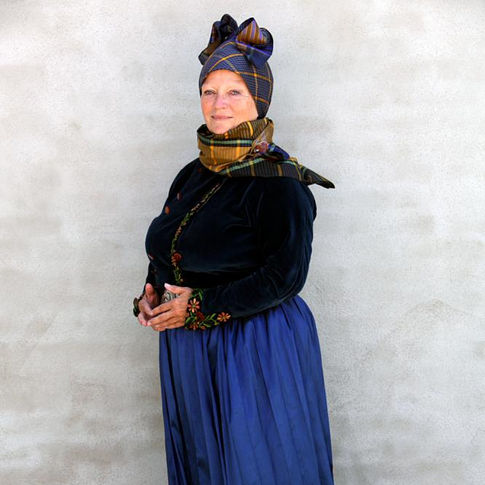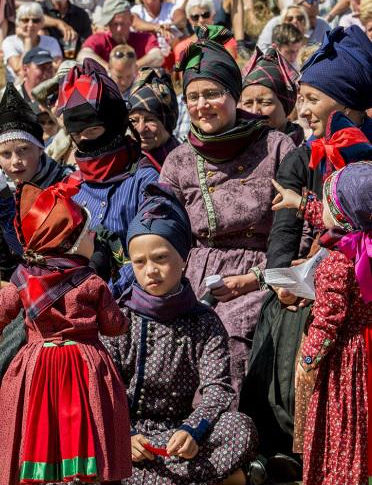
Costume gallery
Below you can see examples of different types of Sønderho costumes:
Everyday costume – Sunday afternoon costume – Festivity costume – Widow costume – Half-Mourning costume – Harvest costume – Young girl costume – Child costume – Confirmation costume – Communion costume – Wedding and bridesmaid costumes
EVERYDAY COSTUME
Traditionally, it was customary for younger women to wear floral-patterned everyday costumes, while the costumes of older women were darker and possibly had only a small pattern.
The everyday costume consists of a cotton dress with red ribbon trimmings, metal buttons, and cotton cloths. A more refined version of the everyday costume features amber buttons and silk scarves.

SUNDAY COSTUME
A blue velvet bodies (“nattrøje”) with amber buttons and finely embroidered floral ribbons in golden and green colours. An apron made of blue silk taffeta, blue and golden silk scarves.

FESTIVITY COSTUME
The exquisite festivity costumes are often crafted from silk or fine wool, and the bodice features intricately embroidered floral bands on the front and cuffs, along with silver buttons.
At times, the bodice may also be made of velour and adorned with beautiful amber buttons. Around the waist, a velvet belt with a filigree or Art Nouveau silver buckle is worn. On special occasions, the belt can be replaced with a velvet ribbon featuring silver tips at the ends, similar to what is seen on bridal attire. A fine silk/cotton scarf is tied around the head and neck, which can either match or contrast with the outfit.
The splendid fabrics and silver buttons were brought to Sønderho by sailors who acquired them from various corners of the world. The same applies to the scarves, resulting in significant variations in their appearance. The original scarves have become delicate over time and are no longer usable. Hence, it was delightful that Jørgen Engel, during his work in Bangladesh, collaborated with a Danish woman who owns a silk weaving workshop to recreate the traditional "cloths." Today, they can be purchased at Lorenzens Shop.
The men would don their finest attire, and the affluent captains and ship owners had the option to have their elegant captain's costumes tailored by a skilled tailor, perhaps in Hong Kong. In the image below, he is wearing brown velvet trousers, white woolen stockings with tassels, and shoes with silver buckles. Additionally, he adorns a yellow silk waistcoat, a long woolen jacket with silver buttons, and a tall hat on his head.

WIDOW'S COSTUME
The widow's costume is black with black buttons and embossed black velvet ribbons.
Around the neck and head, widow's cloths are worn - dark blue cotton scarves. If a widow did not remarry, she was expected to wear the costume for the rest of her life.
The widow could also wear blue silk cloths with the costume, for example, if she were attending a festive occasion.

HALF-MOURNING COSTUME
The half-mourning costume is characterized by muted colours, typically in shades of gray, mauve, or lavender. It is worn during the intermediate stage of mourning, when the bereaved individual is gradually transitioning out of deep mourning.
The costume may include dresses or suits in subdued tones, often with subtle patterns or trims. The use of black is reduced, and other colours are gradually introduced. Accessories such as ribbons, veils, or brooches may feature softer shades of gray or lavender.
The duration of the half-mourning period can vary depending on cultural and personal preferences, but it typically lasts for several months to a year. It serves as a symbolic representation of the grieving process and the gradual return to normalcy and social activities.

HARVEST COSTUME
The women on Fanø had to manage all the practical tasks themselves when their husbands were out at sea. Therefore, they had a special work costume for harvesting and worm digging. The costume consists of an old bodice ("nattrøje") and red cloths, a red coarse wool skirt, and an apron.
When the harvest was nearing its end, they would put on a white cotton apron to celebrate the occasion. They would tie a woven kilting ribbon around the skirt and apron, allowing the skirt to be pulled up. To protect their faces from the sun and wind, they would tie a face mask (“strude”) around their faces, which was a black face mask with only the eyes visible. This way, they could protect their skin to keep it fair and wrinkle-free. It was mostly the young women who wore the face mask.

YOUNG GIRL COSTUME
After confirmation and until engagement/marriage, young girls wore a small-flowered costume with a red wool skirt. When the red skirt was later replaced by a green wool skirt (the adult costume), the red skirt was worn underneath the green one. The green skirt could be pulled up over the head when the weather was bad and function as a shawl.
The girls in the pictures here are wearing cotton costumes with red or green cotton cloths and red star ribbons.

CHILDREN'S COSTUME
Infants were swaddled in a small cotton costume with a bonnet. Later, the little girl would wear a floral costume with a bodice and an apron. The ribbons were usually woven. On the head, the child wore a small velvet bonnet with silk ribbons tied in a bow on top. Around the neck, a cotton cloth was worn. The skirt was made of red wool.
The little boys wore dresses (“kjole”) until they turned 5. After that, they were given trousers and a jacket.

CONFIRMATION COSTUME
The costume consists of a black dress with silver buttons. The bodice can be silk or velour, and the ribbons are small star-patterned. The apron is black silk or wool. On her head, she wears a black velvet bonnet, edged with embossed black velvet ribbons. Under the bonnet, a lace trim is visible. Tied around the bonnet is a black velvet ribbon with silver tips that hangs down the back. Around the waist, a belt with a silver buckle is worn.
Around the neck, a black and white silk cloth is tied, possibly with red stripes. The bonnet and cloth are later used for the communion costume, and both are placed in the grave with her. Therefore, it is rare to find an original confirmation cloth.

COMMUNION COSTUME
For religious holidays or when the child was to be baptized, she would dress in a communion costume.
The blouse was her bridal blouse, and underneath she wore a black festive blouse. A piece of brocade was inserted in front of the chest, which could be seen as the bridal blouse was not fastened in the front. Around her neck, she wore the black-and-white silk scarf from her confirmation, and on her head, the confirmation bonnet. If she was not going to partake in communion, the bonnet could be replaced with a festive cloth.
The baptismal child was dressed in a christening gown, which was sewn in silk and adorned with magnificent embroideries. On the head, a small cap was worn, which differed between boys and girls.

BRIDE AND BRIDESMAIDS COSTUMES
The bride is always accompanied by one or more young/adult bridesmaids.
The bride's costume consists of a bridal bodice, which is black wool, edged with black velvet ribbons. It is not buttoned in the front but fastened at the top and bottom. A piece of brocade is placed in front of the bodice. At the bottom, she wears a black festive bodice, which can be seen as she rolls up the bridal bodice at the wrist.
Around her neck, she wears a white scarf edged with lace, and on her head, she wears a "bore" - a kind of crown adorned with artificial flowers and pearls, equipped with a mirror.
The "bore" is sewn into the hair. The skirt is made of black wool, edged at the bottom with velvet ribbons. Around her waist, she wears a velvet ribbon with tips. The apron is white cotton edged with lace or lace trimmings.
The bridesmaids, like the bride, wear a "bore" on their heads, but without a mirror. The bridesmaids are dressed in a festive bodies and a fine silk scarf, a green wool skirt, and a white apron like the bride.
The little bridesmaids have a flower wreath in their hair but used to wear a "bore" like the adult bridesmaids. It has not been practically possible in recent times, so the foundation "Fonden Gamle Sønderho" has chosen to give the little bridesmaids flower wreaths instead.


























